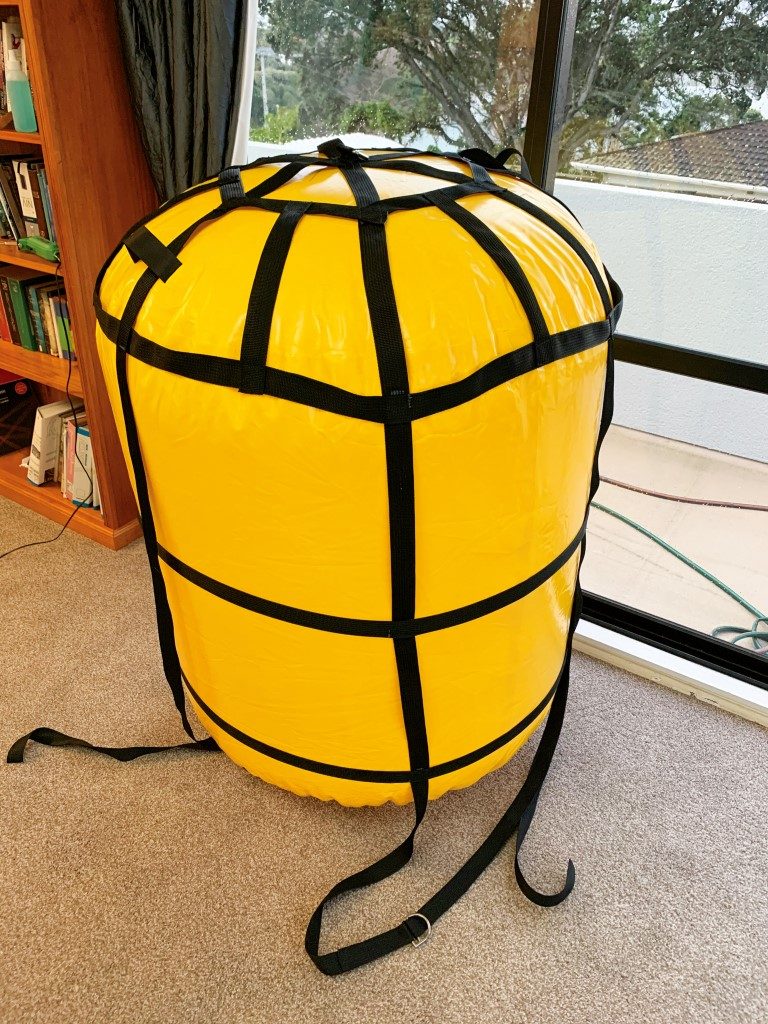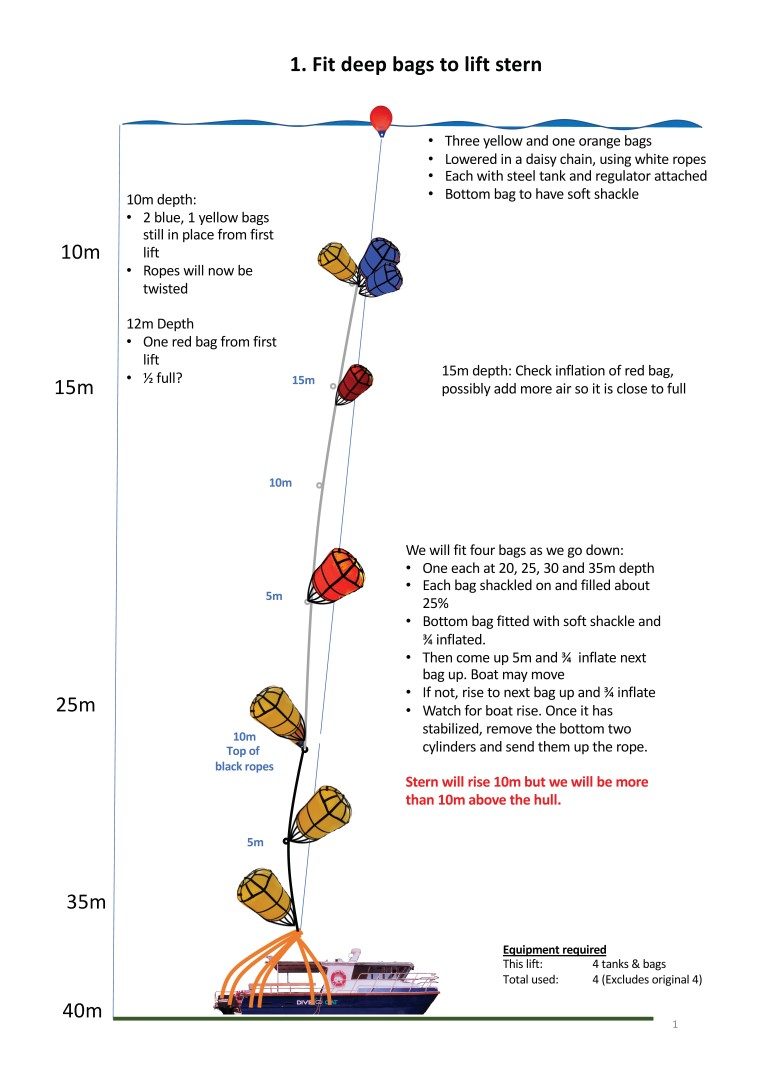

Most people would cut their losses if their boat sank in 43 metres of water, but Norman Holtzhausen’s not most people. He was determined to salvage his boat himself.
On 6th Feb 2020 my boat Divecat sank while returning from a scuba diving trip to Great Barrier Island. The cause of her sinking will be explained in a future article because it, like many things, was the result of a series of smaller issues that together created the perfect storm. She sank in 43m of water right in the middle of the Firth of Thames, an exposed patch of water known for its fierce tidal stream.

In the hectic days after Divecat’s sinking, I approached several salvage companies and experts about the prospects of recovering her. The consensus was it would be prohibitively expensive, because of her depth and location. None of the companies wanted to take on the job, and the insurance company declined to finance any recovery attempt. And then our first Covid lockdown struck!
Now with plenty of time on my hands, I started researching salvage options to work out the feasibility of recovering Divecat myself. I watched many videos of people raising objects from the seabed, and sufficiently scared myself into realising this was not a job to be undertaken lightly. Using numerous heavy lift bags was realistically the only way to do it, but once a sunken object starts to lift it begins a hugely dangerous runaway ascent. Scuba divers know this from Boyle’s Law – any volume of gas underwater expands as it rises. Hence getting just enough lift to move Divecat off the bottom would instantly become too much lift as soon as she was just a metre or two higher.

So, armed with a healthy dose of caution, I looked online for suitable lift bags. Automatic dump valves were required to vent the expanding air as the bags ascended. Very large lift bags are, however, not something you can easily buy off-the-shelf, so I had to find some super-strong airtight bags of the right shape and size and then modify them. Gymnasium rollers seemed about the right size with close to a cubic metre of air volume, so I ordered a couple from AliExpress to try out.
After looking at many videos and pictures of other salvage efforts, I designed and sewed up a webbing harness to contain the vinyl bag. I even subjected different webbing to breaking-strength tests to choose the strongest type available. The finished unit was tested in shallow water first, and then slightly deeper water, with appropriate alterations as deficiencies in my design were discovered. It took several tests and design changes before I was confident that they were up to the job.

Then came the lift plan itself. Because of the danger of runaway, the only safe place for any divers to be during the lift process was above the boat but below the lift bags. I therefore devised a strategy whereby we would lift her just five metres at time. This involved long, strong (and expensive!) ropes with shackles pre-tied every five metres along their length. At each stage of the lift the boat would only rise five metres at a time.
Apart from the initial deep dive to fit the straps and ropes, the recovery divers would spend most of the operation at depths of only 10m to 15m – an important consideration for diver safety. We would fit new bags no deeper than 15m. Once they were sufficiently full the boat would lift only until the topmost bags reached the surface. Those 15m deep bags would now be at 10m, and so the cycle would continue until the boat itself was hanging just 5m below the surface.
Crucial to the success of this stage of the operation was the tide. I had to time the whole exercise so that Divecat lifted from the bottom just as the tide started to come in. With a tidal stream out there of up to one-and-a-half knots, a full tide cycle would take us six or seven nautical miles towards shallower waters. The plan was to combine this with a sideways pull with our dive boat, easing her towards the shores of the Coromandel Peninsula. Our target was Elephant Cove in the Happy Jack group of islands, with a gently shoaling, pebbly beach that we could use for the final floating. However, any location in less than 30m of water would have been a win.

In between all this planning and preparation there was the problem of finding her current resting place. Several unsuccessful search attempts using a fishfinder showed that she was nowhere even close to the final onboard GPS location reading. Reluctantly I resorted to Facebook, knowing the torrent of abuse this would generate from the usual internet trolls. Which it did, but it also served its purpose and pretty soon I had the boat’s exact co-ordinates. It turns out that a commercial fisherman had wrapped his net around an object that should not be there!
Divecat had drifted almost a full nautical mile from her last broadcast location before eventually going down to the bottom.
And then another curveball was thrown my way when I suffered a heart attack in November 2020. This put paid to my diving for three months, just at that crucial phase where I now knew where my boat was and was desperate to see what condition she was in. Was I wasting my time, or was she still worth salvaging?
Champing at the bit, I eventually got a clean bill of health after Christmas, and my dive buddy and I set out on the first deep dive to her. The relief on seeing her sitting upright on the bottom, undamaged and in good condition, cannot be described. The hull was solid, and interestingly a set of cleats that were welded directly to the hull were acting as anodes, preventing serious corrosion elsewhere. “Raising the Tintanic,” as my wife called my obsession, was definitely still a viable project!

Since at this stage I had no formal qualifications for deep diving, I immediately signed up for some appropriate training, which also necessitated upgrading my dive gear. That first dive had been a very quick drop-down-and-look, but to achieve anything significant I needed to spend a reasonable amount of time at 43m. This required technical diving skills, and I set about acquiring these. With the right gear and training, plus a range of gas blends, we could get 25 minutes at the bottom, with another half an hour or more of decompression stops on the way back to the surface. Not a long time, especially since we could only dive exactly at slack tide, but it would have to do.
The final plan for her salvage evolved over the course of the following year and a total of 18 deep dives, going down to her whenever weather conditions allowed. Decompression stops in the middle of winter were very unpleasant and I invested in electrically-heated scuba vests to keep us warm. That darned fishing net both complicated access and greatly increased the risk of diver entanglement. We spent some time trying to cut it off, with only partial success, and recovered a few items from the hull as mementoes. Finding secure locations to attach lifting straps remained the main challenge, and several options were explored.

Eventually I had an epiphany – Divecat did not need to be lifted horizontally but could be dragged up stern-first. This had several positives, mainly that the first stage of the lift would only partially raise her. Enough buoyancy to cause her stern to rise was not enough to lift her completely free of the bottom. This approach also meant I could then more accurately gauge the total lift required for a slow and controlled ascent that avoids any runaway.
The other point I had learned from my earlier trials was to massively over-spec everything. I had calculated that her eight-tonne surface weight would require just under six tonnes of lift under water, thanks to the displacement offset of the aluminium and internal furnishings. So, I organised a total of 18 tonnes of available buoyancy in 20 lift bags. We fitted 11-tonne lifting straps through each of her four scuppers, and one around each of the outboard motors. The lift ropes each had a breaking strain of over six tonnes.

The net result was that any one of the six lifting points were theoretically capable of supporting the whole boat once she was off the bottom. The plan could cope with multiple individual equipment failures and still succeed overall, although you can only plan for contingencies you think of!
Now we were ready for the big day! Waitangi Day 2022 was the target date, which would have made it precisely two years to the day since Divecat sank.





